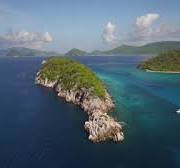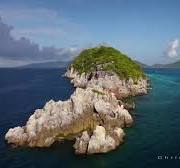Congo Cay, USVI: A Secluded Paradise of Natural Beauty, Marine Life, and Adventure
Congo Cay, a pristine and uninhabited island in the U.S. Virgin Islands (USVI), offers a unique blend of natural beauty, seclusion, and marine biodiversity. Located just north of St. John, Congo Cay is part of the Virgin Islands National Park, which preserves and protects much of the region’s unspoiled wilderness and underwater ecosystems. This small cay, with its rugged coastline, crystal-clear waters, and vibrant coral reefs, serves as a haven for nature lovers, snorkelers, and adventurers seeking an off-the-beaten-path experience.

Aerial view of Congo Cay
Geography and Location
Congo Cay is situated in the Caribbean Sea, forming part of the archipelago that makes up the U.S. Virgin Islands. It lies between the islands of St. Thomas and St. John, a short distance from both, making it accessible yet remote enough to maintain its pristine character. The cay is surrounded by deep, azure waters that transition to lighter turquoise shades near its shoreline and coral reefs. The landmass itself is characterized by rocky cliffs, dense vegetation, with a surplus of the indigenous tyre palm tree.
Biodiversity and Marine Life
The waters surrounding Congo Cay are teeming with marine life, making it a popular destination for snorkeling and scuba diving. The coral reefs are home to a variety of hard and soft corals, which create a vibrant underwater landscape. These reefs provide shelter to an array of marine species, including parrotfish, angelfish, sea turtles, and the occasional nurse shark. For snorkelers, the shallow reefs around the cay offer an intimate view of this underwater wonderland, while deeper dives reveal the mysteries of the surrounding ocean.
Above water, the cay’s rocky outcroppings and vegetation support a variety of seabirds, such as brown pelicans, frigatebirds, and tropicbirds. These birds can often be seen soaring overhead or nesting on the cliffs, adding to the island’s dynamic ecosystem.
History and Cultural Significance
While Congo Cay itself is uninhabited, its proximity to St. John and St. Thomas ties it to the rich history of the U.S. Virgin Islands. The archipelago has been influenced by various cultures over centuries, including the Taíno people, European colonists, and African slaves. Remnants of this history are evident in the nearby islands, where sugar plantation ruins and historic trails tell the stories of resilience and cultural fusion.
The name “Congo Cay” may evoke ties to Africa, reflecting the region’s colonial past and the transatlantic slave trade, which brought many Africans to the Caribbean. While there are no specific historical structures on the cay itself, the surrounding waters and neighboring islands bear witness to this complex history.
Activities and Attractions
Congo Cay’s natural beauty and seclusion make it an ideal destination for a variety of activities. Visitors typically reach the cay by boat, as there are no direct ferry services or infrastructure on the island. Private charters and guided tours departing from St. John or St. Thomas often include Congo Cay as part of their itinerary, allowing travelers to experience its untouched charm.
Snorkeling and Scuba Diving
One of the primary draws of Congo Cay is its exceptional snorkeling and diving opportunities. The reefs around the cay are some of the healthiest in the Virgin Islands, offering a kaleidoscope of colors and marine species. Popular snorkeling spots include shallow coral gardens and ledges where schools of fish gather, creating an underwater spectacle.
For scuba divers, Congo Cay provides access to deeper reefs and underwater cliffs. These sites are often less crowded than other dive locations in the USVI, allowing for a more tranquil and immersive experience. Visibility in the area is typically excellent, often exceeding 100 feet, making it a paradise for underwater photography.

The rugged Western tip of Congo Cay
Wildlife Watching
For bird enthusiasts, Congo Cay offers a chance to observe seabirds in their natural habitat. The cliffs and rocky areas of the cay are important nesting sites, making it a haven for birdwatching. Visitors might also spot dolphins or sea turtles swimming in the surrounding waters, adding to the cay’s allure.
Environmental Conservation
Congo Cay is part of the Virgin Islands National Park, which emphasizes the importance of preserving the natural environment. Efforts to protect the cay and its surrounding waters include strict regulations on fishing, anchoring, and other activities that might harm the delicate ecosystems. Visitors are encouraged to practice “leave no trace” principles, ensuring that the cay remains pristine for future generations.
In summary, Congo Cay is a hidden gem within the U.S. Virgin Islands, offering unparalleled natural beauty, diverse marine life, and a sense of tranquility that is increasingly rare in today’s world. Whether you are snorkeling among vibrant coral reefs, kayaking along its rugged shoreline, or simply basking in the serenity of its untouched landscape, Congo Cay provides an unforgettable experience for those who seek to connect with nature. As a part of the Virgin Islands National Park, it stands as a testament to the importance of conservation and the enduring allure of the Caribbean’s unspoiled treasures. Ask your captain if the conditions are right for a memorable snorkel at Congo Cay!
